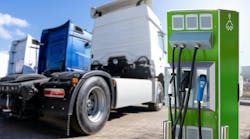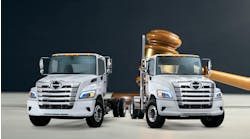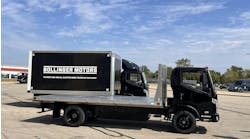Phase 3 of the Clean Trucks Plan: A tale of two trucking perspectives
While trucking organizations continue to push back on regulators’ proposed environmental rules for heavy trucks, vehicle manufacturers and suppliers are ready to see the Clean Trucks Plan through. Both groups, however, see charging infrastructure as an obstacle to meeting the goals of the current proposed rules.
It’s been more than a year since the U.S. Environmental Protection Agency established its final rule for Phase 1 implementation of its Clean Trucks Plan—regulations to reduce emissions from heavy-duty vehicles and engines beginning in model year 2027.
The Clean Trucks Plan—with 80% stronger standards than what’s current, according to the EPA—will take effect in phases. Phase 1 sets standards for the control of air pollution from heavy-duty engines and vehicles; Phase 2, proposed on April 12, 2023, sets emissions standards for model year 2027 light- and medium-duty vehicles; Phase 3, proposed alongside Phase 2 in April 2023, sets GHG emissions standards for heavy-duty vehicles.
HDLG support
A group of heavy-duty vehicle and engine stakeholders are ready to support the proposed Phase 3 rule—if the EPA amends it to include technology-neutral regulations.
On Feb. 6, four big-name vehicle and engine manufacturing and supply companies announced an alliance supporting the EPA Phase 3 rule. BorgWarner, an automotive and e-mobility supplier; Cummins, an engine manufacturer; Eaton, a power management company; and Ford, a global vehicle manufacturer, joined together to encourage the finalization of the Phase 3 rule by March 31.
Known as the Heavy-Duty Leadership Group, the four companies released a joint “Statement of Principles” calling for no delay in the planned Phase 3 start date of model year 2027 and rejecting proposals to delay the rule’s start until 2030.
The HDLG also opposed a “hard-wired off-ramp” Phase 3 rule proposal that would essentially weaken Phase 3’s standards if adequate charging infrastructure needs are unmet. Instead, the HDLG proposed the EPA conduct an ongoing “‘technical assessment’ of infrastructure development, battery costs, rare minerals sourcing, and other critical issues,” according to a press release.
In the statement, the companies also stressed the importance of having technology-neutral regulations, which would “provide (the) industry with the confidence to deploy capital and resources that will result in high-quality job growth and technology leadership, which are critical in the de-carbonization of the transportation sector.”
“Multiple technology pathways exist and must be considered in a technology-neutral manner to achieve EPA’s performance-based HD Phase 3 GHG standards,” the statement continued. “These solutions include hybrid powertrains; advanced engine technologies; hydrogen combustion; and electric and hydrogen zero tailpipe emission propulsion systems.”
Additionally, the HDLG alliance believes that meeting these targets will require a whole-of-government approach, stating the “DOE, DOT, EPA, and other Federal, state, and local government agencies” must work with the private sector to “leverage a commercially viable HD infrastructure, which accelerates the adoption of zero-emission commercial vehicles.”
EPA Phase 3 pushback
While manufacturers and suppliers are ready to continue working on designing and manufacturing their lower-emission vehicles, trucking organizations that represent the end user criticized the EPA’s proposed rule for Phase 3 of the Clean Trucks Plan soon after it was released because it did not consider charging infrastructure development.
While the president of the Truck and Engines Manufacturer Association agrees with the HDLG that meeting these targets will require a whole-of-government approach, he believes the EPA rule should focus more on charging infrastructure.
“We need a whole-of-government approach to solve the problem and meet the challenge. EPA should do its part by adopting a final rule that includes a requirement to assess progress on the development of the needed infrastructure,” said EMA President Jed Mandel in testimony to the EPA on May 3, 2023.
The American Trucking Associations also responded: “The Phase 3 standards must take into account the complex challenges and operating conditions facing motor carriers as we manage the transition to a zero-emission future while simultaneously moving more than 72% of the economy’s freight,” ATA President and CEO Chris Spear said.
Meeting emissions targets
Many companies in various industries have set their own environmental, social, and governance goals, known as ESG, and companies in the transportation and automotive sectors are no different.
BorgWarner outlines its ESG and sustainability goals on its website, stating the company “expects to achieve approximately 35% of sales from eProducts in 2025 and 49% in 2027.” Cummins’ Planet 2050 initiative aims to reach carbon neutrality and have a “net-positive impact” in every community the company operates by 2050. Eaton also outlines goals to reduce GHG emissions by 50%, have each facility achieve zero-waste-to-landfill certification, and invest $3 billion in sustainable solutions—all by 2030. Finally, Ford’s “Vision for the Future” includes carbon neutrality by 2050, zero-emissions vehicles and facilities, using local and renewable energy in its manufacturing facilities by 2035, and eliminating single-use plastics from operations by 2030.
In addition to their own ESG goals and climate commitments, commercial vehicle manufacturers and suppliers must also adhere to the emissions targets of the countries in which they operate. The EPA requires automakers to reach a target of 187 carbon dioxide grams per mile by 2026 for light-duty trucks that operate in the U.S., down from 234 in MY 2023. The National Highway Traffic Safety Administration requires U.S. light-duty trucks to exhibit a fleet-wide average fuel economy of 48 mpg by 2026, nearly a 10-mpg increase from model year 2021.
President Biden also signed an executive order in 2021 setting a target of making 50% of passenger cars and light-duty trucks zero-emission vehicles by 2030. In 2022, at the COP27 climate summit in Egypt, the U.S. energy secretary agreed that 100% of U.S. medium- and heavy-duty vehicle sales and production would be zero-emissions vehicles by 2040.
In Europe, light commercial vehicles and passenger cars account for 12% of total European Union emissions. From 2025 to 2029, light commercial vehicles, or vans, that operate in the EU must meet the emissions target of 153.9 grams of CO2 per kilometer, and between 2030 and 2034, vans must meet the target of 90.6 g/km. From 2035 forward, vans in the EU must adhere to emissions targets of 0 g/km.
Proposed EU emissions regulations for heavy-duty vehicles include a 45% reduction of heavy-duty vehicle emissions by 2030, 65% reduction by 2035, and 90% emissions reduction of heavy-duty vehicles by 2040.
Investing in the future
With both groups stating a whole-of-government approach is necessary to achieve emissions targets along with working alongside the private sector, it’s evident that these lofty goals proposed by a company, politician, or governing body rely on support from one another to see them through. Not only is each entity’s reputation at stake if an agreement can’t be made, but so are trillions of dollars worth of investments.
Vehicle and engine manufacturers have already invested and continue to invest trillions of dollars into emissions reduction technologies. A 2022 Reuters study found that 37 global automakers plan to invest $1.7 trillion into electric vehicles and battery technologies through 2030 alone. This doesn’t include investments in hybrid technology or emissions-reducing technologies with current diesel and gasoline engines.
While the HDLG, EMA, and ATA can agree on a whole-of-government approach to address the challenges associated with meeting strict emissions targets, it will likely take a “whole-of-industry” approach to see it through.




